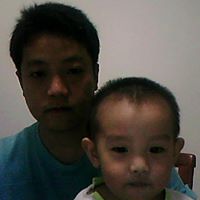Jianfeng Wang
age ~36
from Temple City, CA
- Also known as:
-
- Jian Feng Wang
- Jian F Wang
- Juan F Wang
Jianfeng Wang Phones & Addresses
- Temple City, CA
- Freehold, NJ
- Flushing, NY
- Rowland Hghts, CA
Us Patents
-
Flexible Mac Superframe Structure And Beaconing Method
view source -
US Patent:8467357, Jun 18, 2013
-
Filed:Dec 5, 2008
-
Appl. No.:12/746279
-
Inventors:Jianfeng Wang - Ossining NY, US
Dave A. T. Cavalcanti - Ossining NY, US
Kiran S. Challapali - New City NY, US -
Assignee:Koninklijke Philips Electronics N.V. - Eindhoven
-
International Classification:H04W 4/00
-
US Classification:370338
-
Abstract:A flexible wireless system and method that support both centralized and distributed modes of MAC protocols, use a new recurring MAC superframe comprising: a beacon period, a data/sense/sleep period for data selective communication, sleep and channel sensing for detecting primary users in cognitive systems; and a signaling window used for exchanging network entry messages and channel reservation requests, the system including beacon operation, a peer beacon device in distributed mode and a master beacon device in centralized mode which are used to selectively participate in the beacon operation, as well as a slave beacon device associated with the master device. The system may employ controlled channel access for the beacon period, the channel access being reservation based. The invention provides a unified MAC protocol that can be adopted in the standards, and supports flexible operation in distributed mode or centralized mode, and seamless transfer from one to the other.
-
Distributed Scheduling Of Quiet-Period For In-Service Channel Monitoring
view source -
US Patent:8576747, Nov 5, 2013
-
Filed:Nov 24, 2008
-
Appl. No.:12/744422
-
Inventors:Jianfeng Wang - Ossining NY, US
Kiran S. Challapali - New City NY, US
Dave A. T. Cavalcanti - Ossining NY, US -
Assignee:Koninklike Philips N.V. - Eindhoven
-
International Classification:H04L 12/28
-
US Classification:370254
-
Abstract:In a distributed-control cognitive radio network, each secondary user () in a network broadcasts parameters () that indicate the minimum quiet-period sensing demand for regular quiet-periods that the device requires for reliable detection of a primary user (). Each device () in the network adjusts its quiet-period sensing rate to accommodate the highest minimum sensing demand (), thereby providing optimal efficiency relative to quiet-period support while assuring that all devices () in the network are provided at least their minimum quiet-period sensing demand (). Both the interval between regular quiet-periods and the duration of these quiet-periods are negotiated among the devices on the network (). A quiet-period index () is used to synchronize all of the devices to a common time base. Techniques are also provided for efficient coordination of on-demand quiet-period requests, and for supporting different quiet-period schedules for multiple classes of primary users.
-
Network Entry And Device Discovery For Cognitive Radio Networks
view source -
US Patent:20100246434, Sep 30, 2010
-
Filed:Nov 24, 2008
-
Appl. No.:12/744409
-
Inventors:JIANFENG WANG - OSSINING NY, US
KIRAN CHALLAPALI - NEW CITY NY, US -
Assignee:KONINKLIJKE PHILIPS ELECTRONICS, N.V. - EINDHOVEN
-
International Classification:H04L 12/26
H04L 12/28 -
US Classification:370253, 370255
-
Abstract:A device () scans and classifies each channel within a spectrum of channels (-) as being occupied or unoccupied (), and, if occupied, whether it is occupied by a primary user (), a secondary user (), or an unknown user (). As a secondary device (), transmissions are avoided on channels occupied by primary users (). The device selectively joins an existing network of secondary devices, or establishes a new network on an unoccupied channel (), based on the quality of service (QoS) that the channel can provide and/or other factors. If the device is paired with a target device (), the paired device advertises itself on a selected channel (-) for a period that is at least as long as the time required to scan all channels, to facilitate discovery in the event that the target device is also in a search mode. The advertising duration randomly alternates () among integer multiples of the scan duration.
-
Channel Management Method In A Distributed Spectrum Cognitive Radio Network
view source -
US Patent:20100271948, Oct 28, 2010
-
Filed:Dec 5, 2008
-
Appl. No.:12/746261
-
Inventors:Kiran S. Challapali - New City NY, US
Jianfeng Wang - Ossining NY, US -
Assignee:KONINKLIJKE PHILIPS ELECTRONICS, N.V. - EINDHOVEN
-
International Classification:H04L 12/26
-
US Classification:370235
-
Abstract:A source-assisted channel management method in a distributed spectrum cognitive radio wireless network handling a source of multimedia stream data handles a plurality of communicating devices () forming a group, and manages channels with no separate controller that is referenced in applicable IEEE standard. The source makes the reservation on behalf of the device group knows traffic schedule, and determines out-of-band channel scanning, back up channel and channel vacation. The method uses a flexible MAC superframe structure and proactively scans for back-up channels which could be used in lieu of the current channel, identifies devices in the group which should vacate a current channel when any one device from the group of communicating devices () detects an incumbent, and make a determination as to when the wireless network should vacate the current channel based on said traffic schedule. The method ensures that no interference is caused to existing users and maintains QoS.
-
Method Of Packet Retransmission And Reception And Wireless Device Employing The Same
view source -
US Patent:20100284340, Nov 11, 2010
-
Filed:Jan 23, 2009
-
Appl. No.:12/812640
-
Inventors:Vasanth Gaddam - Tarrytown NY, US
Monisha Ghosh - Chappaqua NY, US
Jianfeng Wang - Ossining NY, US -
Assignee:KONINKLIJKE PHILIPS ELECTRONICS, N.V. - EINDHOVEN
-
International Classification:H04W 40/00
-
US Classification:370328
-
Abstract:A first wireless device communicates data to a second wireless device. The first wireless device employs at least one of a first interleaving scheme and a first sub-carrier mapping scheme to produce a first data packet from a first plurality of data bits, and transmits the first data packet to the second wireless device. When the first data packet is not received correctly by the second wireless device, then the first wireless device employs at least one of a second interleaving scheme and a second sub-carrier mapping scheme to create a second data packet from the first plurality of data bits, and transmits the second data packet to the second wireless device.
-
Multiple Channel Support In Distributed Wireless Systems
view source -
US Patent:20100304772, Dec 2, 2010
-
Filed:Dec 5, 2008
-
Appl. No.:12/746271
-
Inventors:Jianfeng Wang - Ossining NY, US
Kiran S. Challapali - New City NY, US -
Assignee:KONINKLIJKE PHILIPS ELECTRONICS, N.V. - EINDHOVEN
-
International Classification:H04W 74/00
-
US Classification:455509
-
Abstract:To facilitate multi-channel communications over distributed-control radio networks, the timing of networks on multiple substantially independent channels are adjusted () so as to establish a common time base among the networks. With this common time base, data is transmitted concurrently (), using the bandwidth provided by the multiple networks. To further optimize the efficiency of this technique for cognitive radio networks, the quiet period (QP) and signaling window (SW) on each network are scheduled () to provide overlapping quiet periods (QP) and/or overlapping signaling windows (SW). Preferably, each multi-channel user is assigned (360) the same time slot in the beacon periods () of the network on each channel, thereby facilitating efficient beacon transmission and reception.
-
Self-Coexistence Of Devices In A Flexible Wireless System Including Two Or More Wireless Networks That Share A Frequency Band
view source -
US Patent:20110255500, Oct 20, 2011
-
Filed:Dec 9, 2009
-
Appl. No.:13/141495
-
Inventors:Dave Alberto Tavares Cavalcanti - Ossining NY, US
Jianfeng Wang - Ossining NY, US -
Assignee:KONINKLIJKE PHILIPS ELECTRONICS, N.V. - EINDHOVEN
-
International Classification:H04W 80/00
H04W 72/04 -
US Classification:370329, 370328
-
Abstract:A method () for enabling self-coexistence of devices in a flexible wireless system () that includes first and second wireless networks sharing a frequency band. The method includes discovering a second device operable in the second wireless network that overlaps with the first wireless network (S); reporting the discovered second device to a first device operable in the first wireless network (S); determining if an adjustment is needed between a first beacon period of the first device and a second beacon period of the second device (S); and adjusting a first beacon period start time (BPST) of the first device with a second BPST of the second device (S) if the adjustment is needed.
-
Channel Reservation In Flexible Wireless Networks
view source -
US Patent:20110261793, Oct 27, 2011
-
Filed:Dec 2, 2009
-
Appl. No.:13/141524
-
Inventors:Dave Alberto Tavares Cavalcanti - Ossining NY, US
Jianfeng Wang - Ossining NY, US -
Assignee:KONINKLIJKE PHILIPS ELECTRONICS, N.V. - EINDHOVEN
-
International Classification:H04W 72/04
H04J 3/00 -
US Classification:370336
-
Abstract:Channel access time slots are reserved in a wireless network employing a flexible medium access control (MAC) protocol. At least a type and a mode of the channel reservation are determined (S). A reservation request frame is generated (S) based on the determined type and mode of the channel reservation. The reservation request frame is sent to a reservation proxy device (S). In response to the reservation request frame, a reservation response frame is received from the reservation proxy device (-RP). Usage of an allocated time slot is announced if a channel reservation request is confirmed in the reservation response frame (S).
Resumes

Jianfeng Wang
view sourceMedicine Doctors

Jianfeng Wang
view sourceSpecialties:
Internal Medicine
Name / Title
Company / Classification
Phones & Addresses
President
J N Roofing & Window
Jinnong Company Ltd
Roofing Contractors
Jinnong Company Ltd
Roofing Contractors
1285 Britannia Rd. E., Mississauga, ON L4W 1C7
(905)6968088, (905)6968089
(905)6968088, (905)6968089
Myspace
Flickr

Jianfeng Wang
view source
Jianfeng Wang
view source
Jianfeng Wang
view source
Jianfeng Wang
view source
Jianfeng Wang
view source
Jianfeng Wang
view source
Jianfeng Wang
view source
Jianfeng Wang
view sourceClassmates

Jianfeng Wang | Southeast...
view source
Southeastern University, ...
view sourceGraduates:
Jianfeng Wang (1998-1999),
Dhyana Parker (1994-1999),
James Gibbs (1997-2002),
Gary Wrona (1963-1965)
Dhyana Parker (1994-1999),
James Gibbs (1997-2002),
Gary Wrona (1963-1965)
Googleplus

Jianfeng Wang
Education:
USTC

Jianfeng Wang
Tagline:
Moo

Jianfeng Wang

Jianfeng Wang

Jianfeng Wang

Jianfeng Wang

Jianfeng Wang

Jianfeng Wang
Youtube
Get Report for Jianfeng Wang from Temple City, CA, age ~36







